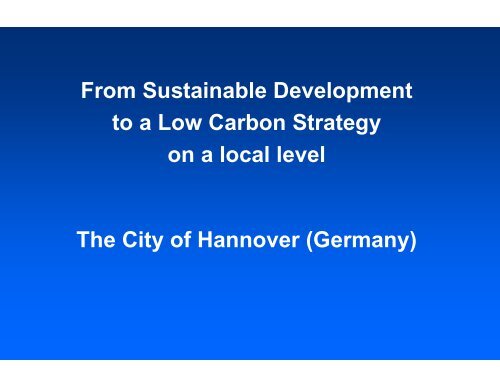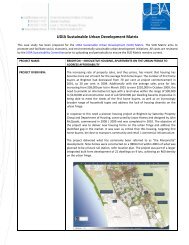From Sustainable Development to a Low Carbon Strategy on ... - UDIA
From Sustainable Development to a Low Carbon Strategy on ... - UDIA
From Sustainable Development to a Low Carbon Strategy on ... - UDIA
You also want an ePaper? Increase the reach of your titles
YUMPU automatically turns print PDFs into web optimized ePapers that Google loves.
<str<strong>on</strong>g>From</str<strong>on</strong>g> <str<strong>on</strong>g>Sustainable</str<strong>on</strong>g> <str<strong>on</strong>g>Development</str<strong>on</strong>g><br />
<str<strong>on</strong>g>to</str<strong>on</strong>g> a <str<strong>on</strong>g>Low</str<strong>on</strong>g> <str<strong>on</strong>g>Carb<strong>on</strong></str<strong>on</strong>g> <str<strong>on</strong>g>Strategy</str<strong>on</strong>g><br />
<strong>on</strong> a local level<br />
The City of Hannover (Germany)
Hans Mönninghoff<br />
• 1974 – 1986 C<strong>on</strong>sultant Engineer<br />
(Water, Energy)<br />
• 1986 – 1989 Member of the State Parliament<br />
for the Green Party<br />
• since 1989 Head of the City of Hannover<br />
Direc<str<strong>on</strong>g>to</str<strong>on</strong>g>rate of Envir<strong>on</strong>mental<br />
Affairs<br />
• since 1997 also Deputy <str<strong>on</strong>g>to</str<strong>on</strong>g> the Lord<br />
Mayor in his functi<strong>on</strong> as Chief<br />
Executive<br />
• since 2005 also Head of Direc<str<strong>on</strong>g>to</str<strong>on</strong>g>rate of<br />
Ec<strong>on</strong>omic Affairs<br />
• until 2013 re-elected in all three functi<strong>on</strong>s<br />
1,800 employees; 370 Mil. Euro budget p.a.
Hannover:<br />
A Liveable City<br />
at the Heart of<br />
Europe<br />
Pop: 520,000<br />
inhabitants<br />
(Regi<strong>on</strong>:<br />
1.1 Mil.)
City of Hannover<br />
• 204 km ²<br />
• Capital and ec<strong>on</strong>omic centre of<br />
<str<strong>on</strong>g>Low</str<strong>on</strong>g>er Sax<strong>on</strong>y<br />
• the world’s largest trade fair<br />
locati<strong>on</strong><br />
• 245.000 jobs in service<br />
industries (e.g. insurances) and<br />
manufacturing and processing<br />
industries (e.g. au<str<strong>on</strong>g>to</str<strong>on</strong>g>mobile)<br />
• 35.000 students in famous<br />
universities
Presentati<strong>on</strong> Overview<br />
1. Sustainability is more than enviromentental<br />
policy! Some challenges of sustainable<br />
development<br />
2. Central fields of a <str<strong>on</strong>g>Low</str<strong>on</strong>g> <str<strong>on</strong>g>Carb<strong>on</strong></str<strong>on</strong>g> <str<strong>on</strong>g>Strategy</str<strong>on</strong>g> as part<br />
of Local Sustainability<br />
3. Some ec<strong>on</strong>omic less<strong>on</strong>s
Challenge I<br />
Demographic Change 2005 - 2050<br />
age<br />
2050 2050<br />
• increase in the proporti<strong>on</strong><br />
of older residents<br />
2005<br />
Men<br />
Women<br />
2005<br />
• increase in the immigrant<br />
populati<strong>on</strong> (now 20% of<br />
the populati<strong>on</strong>) and we<br />
need this people!<br />
Therefore integrati<strong>on</strong> is a<br />
key issue in our work
New answers for planning in the<br />
view of demographic change<br />
• Hannover has good experience<br />
with dec<strong>on</strong>taminati<strong>on</strong> of<br />
polluted sites.<br />
• Special housing-program <str<strong>on</strong>g>to</str<strong>on</strong>g><br />
keep young people in the City<br />
• There is a movement of good<br />
earning older people <str<strong>on</strong>g>to</str<strong>on</strong>g> the City<br />
from the Hinterland
Challenge II: Employment;<br />
„the sec<strong>on</strong>d industrial revoluti<strong>on</strong>“<br />
Jobs in the Hannover<br />
Regi<strong>on</strong><br />
manufacturing and<br />
processing industries<br />
service industries<br />
others (e.g. retail)<br />
<str<strong>on</strong>g>to</str<strong>on</strong>g>tals<br />
1970<br />
140,952<br />
211,535<br />
28,400<br />
380,887<br />
2005<br />
47,100<br />
311,400<br />
15,600<br />
374,100<br />
currently more than 10 % unemployment
Challenge III<br />
Maintaining the Quality of Urban Life<br />
•There are 5 Crucial Soft Locati<strong>on</strong><br />
Fac<str<strong>on</strong>g>to</str<strong>on</strong>g>rs for People & Companies<br />
<str<strong>on</strong>g>to</str<strong>on</strong>g> come and stay<br />
culture<br />
envir<strong>on</strong>ment<br />
urban lifestyle<br />
amenities<br />
greenspaces
Around 50% of the city area in Hannover<br />
is greenspace (105 sqm/ inhab.)<br />
Grünfläche<br />
Wald<br />
Landwirtschaft<br />
Kleingärten<br />
Friedhof<br />
S<strong>on</strong>derfläche<br />
Gewässer<br />
Freibad<br />
Sportfläche<br />
Stadtgrenze
Challenge IV:<br />
New building developments <strong>on</strong>ly al<strong>on</strong>g rail<br />
routes
Challenge V: shopping-situati<strong>on</strong><br />
- minimum out-of-<str<strong>on</strong>g>to</str<strong>on</strong>g>wn<br />
shopping centres<br />
encouraging car use<br />
- support for city centre<br />
shopping<br />
- local shops in the<br />
surrounding districts
Challenge VI:<br />
Socially Resp<strong>on</strong>sible Building is needed<br />
1970s high-rise blocks<br />
> serious social problems<br />
new homes <strong>on</strong> Kr<strong>on</strong>sberg -<br />
max. four-s<str<strong>on</strong>g>to</str<strong>on</strong>g>rey apartment houses with<br />
max. 8 apartments<br />
per stairwell
Why low carb<strong>on</strong> strategies<br />
CO2 emissi<strong>on</strong>s in t per capita<br />
<str<strong>on</strong>g>to</str<strong>on</strong>g>day:<br />
The energy c<strong>on</strong>sumpti<strong>on</strong> in the<br />
developing countries will rise!<br />
USA<br />
Australia<br />
Germany<br />
China<br />
4<br />
10<br />
17<br />
19<br />
The necessity is clear: In order <str<strong>on</strong>g>to</str<strong>on</strong>g><br />
limit global warming <str<strong>on</strong>g>to</str<strong>on</strong>g> 2°C, every<br />
pers<strong>on</strong> in the world should not<br />
produce more than 2 <str<strong>on</strong>g>to</str<strong>on</strong>g>ns per Year.<br />
Otherwise we will be c<strong>on</strong>fr<strong>on</strong>ted<br />
with a climate catastrophe.<br />
Africa<br />
1<br />
0 5 10 15 20
In Hananover Targets set by City<br />
Council:<br />
• 1992: First Climate Protecti<strong>on</strong><br />
Programme, aiming for a 25% cut in<br />
CO 2 emissi<strong>on</strong>s, 1990-2020<br />
• 2008: Klima-Allianz Hannover 2020<br />
40% Reducti<strong>on</strong> from 1990 <str<strong>on</strong>g>to</str<strong>on</strong>g> 2020<br />
• We try <str<strong>on</strong>g>to</str<strong>on</strong>g> come <str<strong>on</strong>g>to</str<strong>on</strong>g> 6,4 <str<strong>on</strong>g>to</str<strong>on</strong>g>ns (inclouding<br />
traffic about 7 <str<strong>on</strong>g>to</str<strong>on</strong>g>ns !)
But it is not <str<strong>on</strong>g>to</str<strong>on</strong>g>o difficult:<br />
There is a lot <str<strong>on</strong>g>to</str<strong>on</strong>g> do<br />
in intelligent use of energy !<br />
The GDP per <str<strong>on</strong>g>to</str<strong>on</strong>g>nne<br />
of CO2 is very<br />
different<br />
in the countries.<br />
Australia 0,8<br />
Germany 2,0<br />
Japan 3,6<br />
Australia is ranked 15th out<br />
of 19 industrial countries !<br />
Report of the Climate Institute (Sep.<br />
2009)
Hannover is an interesting example of oow much, within<br />
existing frameworks and c<strong>on</strong>diti<strong>on</strong>s, can be achieved by a local<br />
authority.
Hannover has powerful instruments:<br />
• Since 20 years a red-green coaliti<strong>on</strong> which really wants a<br />
sustainable development of the city; Ambitious Targets set<br />
by City Council Resoluti<strong>on</strong>s<br />
•<br />
• majority municipal holding in a city energy utility<br />
• Since 1992 a climate protecti<strong>on</strong> unit in the city<br />
administrati<strong>on</strong><br />
• a regi<strong>on</strong>al climate protecti<strong>on</strong> agency involving around 60<br />
instituti<strong>on</strong>s and companies<br />
• a professi<strong>on</strong>ally-led Agenda 21 process with the broadbased<br />
support and involvement of local people<br />
• a climate protecti<strong>on</strong> fund, awarding grants <str<strong>on</strong>g>to</str<strong>on</strong>g>talling 5 milli<strong>on</strong><br />
€ each year for the last 10 years
Some more informati<strong>on</strong> <str<strong>on</strong>g>to</str<strong>on</strong>g> the<br />
‘proKlima’ Fund,<br />
5 milli<strong>on</strong> € per year in subsidies for:<br />
feed of:<br />
- 2 Mio. € additi<strong>on</strong>al charge <strong>on</strong> gas- sale of the utility<br />
- 2 Mio. € from the utility-profit<br />
- 1 Mio. € from the municipality<br />
• house insulati<strong>on</strong><br />
• c<strong>on</strong>structi<strong>on</strong> of <str<strong>on</strong>g>Low</str<strong>on</strong>g> Energy Houses<br />
• high-efficiency heating systems e.g. decentral CHP plants<br />
• extensi<strong>on</strong> of the district heating network<br />
• electricity saving campaigns<br />
• renewable energy use
Results so far: 1990 – 2005<br />
Despite<br />
Positive ec<strong>on</strong>omic growth;<br />
A growing populati<strong>on</strong> (+15,000); and<br />
more electricity use in private households (+32%!)<br />
Greenhouse Gas Emissi<strong>on</strong>s declined by<br />
about 7.5% between 1990 and 2005!
CO 2 Audit for the City of Hannover, 1990 - 2005<br />
CO 2 emissi<strong>on</strong>s<br />
1990 in 1000 t *<br />
Change since 1990<br />
Energy<br />
cus<str<strong>on</strong>g>to</str<strong>on</strong>g>mers<br />
84%<br />
Industry 32%<br />
2,102 -12%<br />
Small commercial 27% 1,797 -8% -8.8%<br />
Private households 25%<br />
1,625 -5%<br />
Transport<br />
16%<br />
Mo<str<strong>on</strong>g>to</str<strong>on</strong>g>rised Traffic 13%<br />
Rail 2%<br />
836<br />
125<br />
-6%<br />
-19%<br />
-0.9%<br />
Air travel 1%<br />
94<br />
+71%<br />
Totals:<br />
6,579<br />
-7.5%<br />
*including upstream emissi<strong>on</strong>s e.g., from gas extracti<strong>on</strong> in Russia
What are the Successes<br />
What are the Challenges<br />
Where do we go <str<strong>on</strong>g>to</str<strong>on</strong>g> reach 40% in 2020<br />
A short walk throw nine thematic Areas<br />
1. Electricity generati<strong>on</strong><br />
2. Municipal energy management<br />
3. Waste management<br />
4. Private households<br />
5. Building standards in new buildings<br />
6. Building Standards in retrofitting<br />
7. Industry<br />
8. Transport<br />
9. Renewables
1. Efficient Electricity Generati<strong>on</strong><br />
Commitment by the local utility <str<strong>on</strong>g>to</str<strong>on</strong>g> reduce the CO 2<br />
fac<str<strong>on</strong>g>to</str<strong>on</strong>g>r for electricity generati<strong>on</strong> from 950g/Kw in<br />
1990 by 25% without using nuclear power;<br />
• 30% of electricity generated from gas and coalfired<br />
plants comes from cogenerati<strong>on</strong> (CHP)<br />
plants. (nati<strong>on</strong>al average: 12 %)<br />
• 21% increase in district heating delivery<br />
by 1990 - 2005<br />
• About 100 decentralised CHPs<br />
making electricity and heating/cooling
2. City Administrati<strong>on</strong><br />
Municipal Energy Management<br />
achieved:<br />
• Between 1997 and 2005, investment and staff training<br />
reduced heating energy c<strong>on</strong>sumpti<strong>on</strong> in the 600 municipal<br />
owned buildings (schools and so <strong>on</strong>) by 24%.<br />
• staff training and programmes with children in schools and<br />
kindergartens is saving 0.5 Mil. € per year energy-costs<br />
way <str<strong>on</strong>g>to</str<strong>on</strong>g> go:<br />
• <strong>on</strong>going c<strong>on</strong>versi<strong>on</strong> <str<strong>on</strong>g>to</str<strong>on</strong>g> district heating and decentralised<br />
CHP<br />
• All City-owned new buildings <str<strong>on</strong>g>to</str<strong>on</strong>g> be built meeting Passive-<br />
House-Standard<br />
• optimal energy-efficiency retrofitting in low-energystandard
3. Waste Management is a part of CO2-reducti<strong>on</strong> strategy<br />
<str<strong>on</strong>g>From</str<strong>on</strong>g> 1989 <str<strong>on</strong>g>to</str<strong>on</strong>g> 2005 dramatic reducti<strong>on</strong>s in waste quantities<br />
in the Regi<strong>on</strong> from 1.3 Mio. <str<strong>on</strong>g>to</str<strong>on</strong>g>ns <str<strong>on</strong>g>to</str<strong>on</strong>g> 350.00 <str<strong>on</strong>g>to</str<strong>on</strong>g>ns<br />
Waste Treatment C<strong>on</strong>cept for<br />
the Hannover Regi<strong>on</strong><br />
(from 2005)<br />
350,000 <str<strong>on</strong>g>to</str<strong>on</strong>g>nnes p.a. residual waste<br />
(unavoidable, unrecyclable)<br />
120,000 t fine fracti<strong>on</strong><br />
> fermentati<strong>on</strong><br />
Gas used for<br />
electricity generati<strong>on</strong><br />
230,000 t coarse fracti<strong>on</strong><br />
(thermal value)<br />
> incinerati<strong>on</strong><br />
Energy used for<br />
electricity generati<strong>on</strong>
The „New Landfill“ – the Regi<strong>on</strong>al Waste Treatment Centre<br />
The Waste Managment System is nearly optimised<br />
incinera<str<strong>on</strong>g>to</str<strong>on</strong>g>r<br />
mechanical sorting and<br />
composting facility<br />
fermentati<strong>on</strong><br />
composting from the<br />
fermentati<strong>on</strong> plant
4. Private Households<br />
achieved:<br />
• Calculated <strong>on</strong> the 1990 housing s<str<strong>on</strong>g>to</str<strong>on</strong>g>ck, there was a reducti<strong>on</strong><br />
in heating demand of around 13%. But with 15,000 more<br />
inhabitants and more living space per pers<strong>on</strong> the <str<strong>on</strong>g>to</str<strong>on</strong>g>tal area<br />
rose by 10%. Therefore, the actual reducti<strong>on</strong> in heating<br />
demand was <strong>on</strong>ly about 4%.<br />
• Private households are c<strong>on</strong>suming 32% more power. There are<br />
more <strong>on</strong>e-pers<strong>on</strong> households, and more computers and<br />
electrical appliances, many of them with stand-by wastage.<br />
way <str<strong>on</strong>g>to</str<strong>on</strong>g> go:<br />
• voluntary commitment by all housing companies <str<strong>on</strong>g>to</str<strong>on</strong>g> a 25%<br />
reducti<strong>on</strong> in energy c<strong>on</strong>sumpti<strong>on</strong> by 2020<br />
• intensive advice programme for inhabitants, especially those<br />
<strong>on</strong> low incomes (socio-political aspects!)<br />
• target: an overall reducti<strong>on</strong> of at least 20%, 1990-2020
5. Standards in new buildings<br />
Energy-Optimized New Houses in Hannover<br />
from<br />
<str<strong>on</strong>g>Low</str<strong>on</strong>g>-Energy Houses (60- 80 % less<br />
than normal new houses<br />
3,000 units built in 1998/1999)<br />
<str<strong>on</strong>g>From</str<strong>on</strong>g> Kr<strong>on</strong>sbergstandard<br />
via<br />
<str<strong>on</strong>g>Low</str<strong>on</strong>g>est Energy Houses<br />
(15 KWh/sqm for Heating)<br />
via Passive houses<br />
<str<strong>on</strong>g>to</str<strong>on</strong>g><br />
Climate Protecti<strong>on</strong> Estate<br />
350 units with Zero Emissi<strong>on</strong>s:<br />
To start in 2010.<br />
To a Zero emissi<strong>on</strong> estate
10 years ago<br />
Kr<strong>on</strong>sberg<br />
greenfield<br />
housing area<br />
60 % less<br />
energyc<strong>on</strong>sumpti<strong>on</strong><br />
than a new<br />
standard house<br />
2,700 units in 3 – 5-s<str<strong>on</strong>g>to</str<strong>on</strong>g>rey apartment houses<br />
directly at the Light-Railway-Net<br />
• 300 2-s<str<strong>on</strong>g>to</str<strong>on</strong>g>rey private terraced houses<br />
Including 2<br />
windmills 80%<br />
less
Today the new standard: "Passive houses"<br />
• excellent thermal insulati<strong>on</strong> (20-<br />
30 cm)<br />
• Houses are oriented <str<strong>on</strong>g>to</str<strong>on</strong>g> the sun<br />
• Used air is extracted by a<br />
ventilati<strong>on</strong> system.<br />
• In the heat transfer it gives 90%<br />
of its heat <str<strong>on</strong>g>to</str<strong>on</strong>g> fresh air.<br />
• On very cold days the fresh air is<br />
post-heated additi<strong>on</strong>ally – quite<br />
normal temperature.<br />
• Sustainably retrofitted is keeping<br />
maintenance costs low, so l<strong>on</strong>gterm<br />
rentable c<strong>on</strong>diti<strong>on</strong> is<br />
ensured<br />
• Passive House comp<strong>on</strong>ents<br />
increase living comfort<br />
Heat transfer
New residential buildings: passive houses<br />
Approx. 100 housing units are ready, 200<br />
more Planned resp. being implemented so<strong>on</strong>,
The Future: Zero emissi<strong>on</strong> houses<br />
Climate protecti<strong>on</strong> estate "In der Rehre"<br />
Detached houses, semi-detached<br />
and terraced houses, 330 Units<br />
Start of c<strong>on</strong>structi<strong>on</strong>: 2010<br />
1. Prize, competiti<strong>on</strong> 2005:
The Future Standard: Zero Emissi<strong>on</strong><br />
Comp<strong>on</strong>ents<br />
Domestic electricity<br />
Heat<br />
100 %<br />
About 50%<br />
Passive houses<br />
+ Quality assurance<br />
(15 kWh/m²a)<br />
CO 2<br />
Reducti<strong>on</strong><br />
Endenergie kWh/m²<br />
About 10% Sun Collec<str<strong>on</strong>g>to</str<strong>on</strong>g>rs for warm<br />
water<br />
About 10% Electricity saving<br />
informati<strong>on</strong>s<br />
25% (the rest)<br />
compensati<strong>on</strong> by a small<br />
Hydro Power Stati<strong>on</strong><br />
nearby<br />
by heat<br />
and<br />
electricity
The North Port Quay as an examble for a<br />
sustainabe development !
The c<strong>on</strong>cept looks good:<br />
•Zero emmissi<strong>on</strong> for heating, cooling and transport by a<br />
energy-saving-c<strong>on</strong>cept and using renewables<br />
•A sustainable water- and waste-c<strong>on</strong>cept<br />
•Short ways, a light rail-system <str<strong>on</strong>g>to</str<strong>on</strong>g> the center of Fremantle<br />
and <strong>on</strong>e smal electro-car at every flat<br />
•The right density of houses and smal shops nearby<br />
…...if the inves<str<strong>on</strong>g>to</str<strong>on</strong>g>rs do, what whey are promissing<br />
(detailed exact c<strong>on</strong>tracts are nessessary!)
6. Building Standards in Retrofitting<br />
municipal buildings<br />
Hannover renovati<strong>on</strong> programme,<br />
2008-2011<br />
• 250 m € investment volume<br />
27 schools,<br />
2 sports halls,<br />
13 children’s day centres<br />
• Ecological standards: 30% better<br />
than the newest legal standard;<br />
Passive House comp<strong>on</strong>ents<br />
26.10.2009 Elisabeth Kirscht<br />
36
Two school–retrofitting-excambles<br />
kWh/m²<br />
600<br />
500<br />
400<br />
end energy demand<br />
for space heating<br />
300<br />
200<br />
100<br />
saving:<br />
75%<br />
saving:<br />
61% 61%<br />
0<br />
Brüder-Grimm-Schule<br />
Alice Salom<strong>on</strong>-Schule<br />
voher C<strong>on</strong>cer<str<strong>on</strong>g>to</str<strong>on</strong>g> Anforderung nachher<br />
26.10.2009 Elisabeth Kirscht<br />
37
Most houses are built!<br />
The future is Retrofitting<br />
EU-Model-Project C<strong>on</strong>cer<str<strong>on</strong>g>to</str<strong>on</strong>g>;<br />
58 buildings with 310 apartements<br />
Passive-House-Standard<br />
Centralised heating system,<br />
c<strong>on</strong>necti<strong>on</strong> <str<strong>on</strong>g>to</str<strong>on</strong>g> district heating<br />
network<br />
Support and advice<br />
for tenants<br />
Electricity saving advice<br />
for all tenants<br />
Training programme for<br />
planners
7. Industry<br />
achieved:<br />
• savings <strong>on</strong> heating 1990-2005 of about 16%<br />
• Electricity demand, driven by ec<strong>on</strong>omic growth,<br />
rose by about 12%.<br />
way <str<strong>on</strong>g>to</str<strong>on</strong>g> go:<br />
• intensive energy efficiency advice campaign<br />
• voluntary commitments by major<br />
commercial/industrial energy c<strong>on</strong>sumers<br />
• A successful project: Ökoprofit
8. Transport<br />
Hannover has a successful L<strong>on</strong>g-Term Transport Plan with<br />
a quite good Modal Split<br />
• 27% <strong>on</strong> foot<br />
• 13% by bicycle (530 km of separate cycle-lanes, 180 km<br />
are running through parks)<br />
• 17% by public transport (10% more in the last 5 years by<br />
rising fuel-prices)<br />
• 41% by car (no increase in cars bey<strong>on</strong>d 1995 level<br />
411 per 1,000 inhabitants)
The success: 92% Energy saving result<br />
in the completed 220 flats !<br />
300<br />
C<strong>on</strong>cer<str<strong>on</strong>g>to</str<strong>on</strong>g>/act2<br />
Energy efficiency retrofitting 2007<br />
Primary energy demand [kWh/m²a]<br />
250<br />
200<br />
150<br />
100<br />
50<br />
0<br />
Before retrofitting<br />
Reducti<strong>on</strong> of primary<br />
energy demand:<br />
Retrofitting<br />
<str<strong>on</strong>g>to</str<strong>on</strong>g> nati<strong>on</strong>al requirements<br />
(EnEV)<br />
for older buildings<br />
Retrofitting<br />
<str<strong>on</strong>g>to</str<strong>on</strong>g> nati<strong>on</strong>al requirements<br />
(EnEV)<br />
for new buildings<br />
Actual<br />
savings<br />
92 %<br />
Actual results<br />
C<strong>on</strong>cer<str<strong>on</strong>g>to</str<strong>on</strong>g> example<br />
52% 67% 92%<br />
City of Hannover C<strong>on</strong>cer<str<strong>on</strong>g>to</str<strong>on</strong>g>/act2<br />
26.10.2009 Elisabeth Kirscht<br />
41
Local Public Transport<br />
• 933 km of Public Transport<br />
routes in the city<br />
• very good Light Rail/U-Bahn<br />
network with 12 routes and 63<br />
Bus routes<br />
• 163 milli<strong>on</strong> Passengers per<br />
year in the regi<strong>on</strong> (+10% in<br />
the last 5 years)<br />
• 160 Mil. € subsidies per year<br />
• good c<strong>on</strong>necti<strong>on</strong>s with the<br />
train network
Transport:<br />
The main successes in Hannover needed,<br />
are at the nati<strong>on</strong>al level:<br />
• In Hannover there is <strong>on</strong>ly few more things <str<strong>on</strong>g>to</str<strong>on</strong>g> do<br />
<strong>on</strong> the local level (more bicycle-lanes, etc.)<br />
• The main successes needed, are at the nati<strong>on</strong>al<br />
level:<br />
- new Cars with less energy c<strong>on</strong>sumpti<strong>on</strong><br />
- higher prices for fuel
9. Renewable Energy<br />
achieved so far:<br />
• Around Hannover, 240 wind turbine genera<str<strong>on</strong>g>to</str<strong>on</strong>g>rs meet<br />
about 8% of the regi<strong>on</strong>’s electricity demand<br />
• hydroelectric potential almost fully exploited at 16<br />
GWh/a; the last <strong>on</strong>e with 3 GWh/a is in planning
Solar energy in Hannover<br />
A focal highlight in the skyline right from the main stati<strong>on</strong>: a<br />
pho<str<strong>on</strong>g>to</str<strong>on</strong>g>voltaic installati<strong>on</strong> <strong>on</strong> a Socio-cultural centre<br />
In the Hannover Regi<strong>on</strong><br />
(1.1 Mio. inhabitants)<br />
3.400 Units Solar Water<br />
Heating (32.000 m²)<br />
1.500 Pho<str<strong>on</strong>g>to</str<strong>on</strong>g>voltaik-Units;<br />
approx. 120,000m²<br />
This covers the electricity<br />
requirement of approx.<br />
3.500 households
1999 a large-scale Solar heating Project<br />
as Backup heating:<br />
Solar city in Kr<strong>on</strong>sberg development area<br />
1.350 m²<br />
roofmounted<br />
collec<str<strong>on</strong>g>to</str<strong>on</strong>g>rs<br />
90 council housing<br />
units<br />
Pilot project costs<br />
3.3Mio. €; 65% of<br />
which is public<br />
subsidy
‘Solarcity’<br />
All in all a 40 % coverage of hot water and heating demand using<br />
solar energy
‘Solarcity’<br />
2.750 m³ thermal s<str<strong>on</strong>g>to</str<strong>on</strong>g>rage tank<br />
landscaped as children's<br />
playground
Microclimate house project at Kr<strong>on</strong>sberg (1999)<br />
4 microclimate z<strong>on</strong>es with<br />
mediterranean vegetati<strong>on</strong><br />
between house secti<strong>on</strong>s with a<br />
<str<strong>on</strong>g>to</str<strong>on</strong>g>tal of 120 flats
25 Solar-School Projects (16 PV, 7 heating)<br />
incorporated in<str<strong>on</strong>g>to</str<strong>on</strong>g> educati<strong>on</strong>al curriculum
An extremely successful programme:<br />
roof areas <strong>on</strong> municipal buildings rented<br />
out for private inves<str<strong>on</strong>g>to</str<strong>on</strong>g>rs<br />
Currently 16 units with<br />
572 kWp<br />
( 5,100 m² area)<br />
Approx. 15 new units<br />
still this year<br />
More in offer next year
The target for renewable Energy : <str<strong>on</strong>g>to</str<strong>on</strong>g> meet more than<br />
20% of Hannover regi<strong>on</strong>’s electricity demand from<br />
renewable sources in the regi<strong>on</strong> till 2020<br />
<str<strong>on</strong>g>to</str<strong>on</strong>g> achieve this:<br />
• replacement of 100 existing wind turbines with<br />
larger models (re-powering)<br />
• c<strong>on</strong>structi<strong>on</strong> of another 60 big wind turbines<br />
• 10% of arable land planted with fuel crops<br />
• increase in pho<str<strong>on</strong>g>to</str<strong>on</strong>g>voltaic-plants
‘Hannover Climate Alliance 2020’ overview -<br />
CO 2 reducti<strong>on</strong> in <str<strong>on</strong>g>to</str<strong>on</strong>g>nnes p.a.<br />
4,640,000 <str<strong>on</strong>g>to</str<strong>on</strong>g>tal emissi<strong>on</strong>s in 1990 = 9.2 <str<strong>on</strong>g>to</str<strong>on</strong>g>nnes per resident*<br />
700,000 supply-side reducti<strong>on</strong>s through energy utility measures<br />
700,000 20% demand-side reducti<strong>on</strong>s by industry, business and<br />
private households<br />
400,000 electricity from renewables in the regi<strong>on</strong><br />
40,000 energy-efficient municipal buildings<br />
1,840,000 <str<strong>on</strong>g>to</str<strong>on</strong>g>tal reducti<strong>on</strong>s by 2020<br />
= 40% below 1990 baseline<br />
= 6,4 <str<strong>on</strong>g>to</str<strong>on</strong>g>nnes per resident<br />
* not including traffic and not including upstream emissi<strong>on</strong>s e.g., from gas extracti<strong>on</strong> in Russia
Last but not least:<br />
More jobs by low carb<strong>on</strong> strategies<br />
• Investment in and technologies for climate<br />
protecti<strong>on</strong> stimulate a dynamic added-value<br />
chain for the regi<strong>on</strong>al craft trades and<br />
businesses<br />
• In the Hannover regi<strong>on</strong> there are already<br />
3,000 people working in climate protecti<strong>on</strong>.
Thank you!<br />
further informati<strong>on</strong>:<br />
www.sustainable-hannover.de<br />
www.hans-moenninghoff.de
















